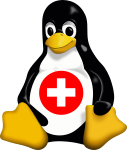Kurze Einführung
Linux ist ein hochstabiles, sehr schnelles und voll funktionsfähiges Unix ähnliches Betriebssystem. Es wurde von einer Gemeinschaft von tausenden von Leuten auf dem Internet programmiert und wird unter der GNU General Public License (Version 2) verteilt, das heisst, es ist frei. Es wird weltweit von mehreren Millionen Leuten, Organisationen und Firmen benutzt.
Zu Linux gibt es verschiedene Distributionen, die jeweils unterschiedliche Software mitliefern, und auch zuweilen die grafische Oberfläche unterschiedlich konfigurieren. Alle Distributionen sind aber zueinander kompatibel.
Eigenschaften
- Keine Werbung vom Betriebssystem selbst!
- Keinerlei Spyware im Betriebssystem!
- Kein Cloud Kontozwang! Eine Anbindung ist natürlich möglich, aber nicht Voraussetzung für den Betrieb.
- Sparsam im Betrieb! Keine Bloatware! Gebt eurem alten Computer ein neues Leben.
- Ideal für Rechner, auf denen nach Ende Windows 10 das Windows 11 nicht läuft.
- Multi-Plattform: Linux läuft auf den verschiedensten Prozessoren, insbesondere x86 und ARM.
- Der ganze Quellcode ist erhältlich, eingeschlossen der ganze Kernel und alle Treiber.
Wer benützt Linux?
Android basiert auf Linux, ergo wird es indirekt von vielen Smartphone und Tablet Usern verwendet. Ansonsten ist Linux aktuell hauptsächlich als Serverbetriebssystem in Verwendung. Fasst alle Internet Server laufen auf Linux.
Auf dem Desktop ist Linux aktuell weniger verbreitet. Es wird vor allem von Leuten probiert, die aus diversen Gründen von Windows oder Mac weg wollen, und in letzter Zeit auch von diversen Verwaltungen, die ihre Abhängigkeit von amerikanischen Konzernen verringern wollen.
Gründe, Linux zu benützen
Es ist schneller, stabiler und besser skalierbar als so manches, kommerzielles System. Anschaffungs- und Unterhaltskosten sind niedrig, was zu einem hervorragenden Preis-/Leistungsverhältnis führt. Die Quellen sind verfügbar. Fehler werden sehr schnell behoben, oft innert weniger Stunden nach der Entdeckung.
Wer leistet Support für Linux?
Es gibt unzählige Webseiten, insbesondere Foren und Wikis, wo Unterstützung geleistet wird. Sie können auch mit Ihrer lokalen Linux User Gruppe (zum Beispiel uns) Kontakt aufnehmen. Wenn Sie kommerziellen Support benötigen, können Sie sich an einen der Distributoren oder eine Firma, die Linux einsetzt und unterstützt, wenden.
